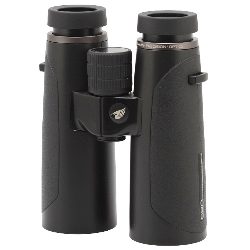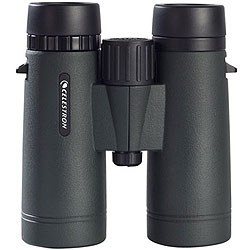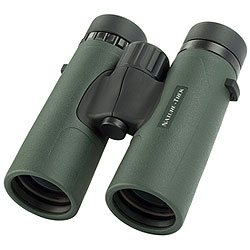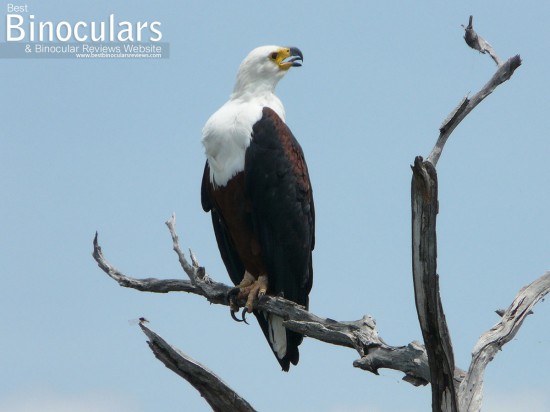10x42 Binoculars for Bird Watching?
Whilst 7x and 8x are probably the most commonly used and recommended magnifications for birdwatching binoculars with the 8x42 configuration being the most popular combination (especially for general, all-round birding). It does not mean that options should be dismissed completely as in some situations a more powerful instrument can make a better option:
Whilst working as a safari guide in South Africa, I used my 10x42 binoculars more than any other, and whilst it is true that I was mostly looking at (and for) much larger and sometimes much scarier animals than birds, I found that in my particular circumstances they also made excellent birding binoculars. So much so, that even if I went out specifically for birding, I would still very often take them with me.
To explain why, in this article, I will take a close look at the main characteristics of 10x42 binoculars (10x magnification and 42mm objective lenses), which will demonstrate why in certain circumstances and some users they may actually be a better choice for bird watching.
I will also go over which types of environments and conditions where 10x42 binoculars will be more suitable for birding than an 8x42 and then lastly, I will recommend a few articles from campingfunzone.com and the best binoculars that I have tested and reviewed over the years.
8x42 vs 10x42 Binoculars
As I have already written an in-depth, but somewhat generalist article (with an included video) on the main advantages the 8x42 vs 10x42 configurations have over each other (see link above), I won’t go over it all again here, rather I will focus on my attention on how they compare against each specifically where bird watching is concerned.
Below you will see just why 8x42 is the most popular choice for general bird watching binoculars, but then we will also discover that in some situations and for some people these advantages may not be as important as the particular strengths that a 10x42 instrument has.
Field of View
The main reason that most people suggest using a lower magnification for birding over something like a 10x binocular is that in general 7x and 8x binoculars will have wider fields of view (FOV).
To illustrate this fact, take look at the FOV’s of the 8x and 10x versions of the same models of binoculars below:
10x42 |
8x42 |
|
 |
 |
|
| GPO Passion HD 10x42 | GPO Passion HD 10x42 | |
| FOV: | 336ft @ 1,000 yards | 375ft @ 1,000 yards |
| Eye Relief: | 17mm | 19.5mm |
10x42 |
8x42 |
|
 |
 |
|
| Vortex Razor UHD 10x42 | Vortex Razor UHD 8x42 | |
| FOV: | 346ft @ 1,000 yards | 420ft @ 1,000 yards |
| Eye Relief: | 16.7mm | 16.7mm |
10x42 |
8x42 |
|
 |
 |
|
| Celestron Trailseeker 10x42 | Celestron Trailseeker 8x42 | |
| FOV: | 6.5° / 341ft @ 1,000 yards | 8.1° / 426ft @ 1,000 yards |
| Eye Relief: | 15mm | 17mm |
10x42 |
8x42 |
|
 |
 |
|
| Carson 10x42 3D Series | Carson 8x42 3D Series | |
| FOV: | 6.0° / 314ft @ 1,000 yards | 6.3° / 330ft @ 1,000 yards |
| Eye Relief: | 16mm | 19.5mm |
10x42 |
8x42 |
|
 |
 |
|
| Hawke 10x42 Nature-Trek | Hawke 8x42 Nature-Trek | |
| FOV: | 5.8° / 304ft @ 1,000 yards | 7.4° / 388ft @ 1,000 yards |
| Eye Relief: | 13mm | 18mm |
10x42 |
8x42 |
|
 |
 |
|
| Kowa 10x42 SV | Kowa 8x42 SV | |
| FOV: | 6.0° / 315ft @ 1,000 yards | 6.3° / 330ft @ 1,000 yards |
| Eye Relief: | 15.5mm | 19.5mm |
10x42 |
8x42 |
|
 |
 |
|
| Snypex 10x42 Knight ED | Snypex 8x42 Knight ED | |
| FOV: | 6.7° / 351ft @ 1,000 yards | 7.5° / 393ft @ 1,000 yards |
| Eye Relief: | 17.2mm | 18.4mm |
What is also important to note that some 10x binoculars with really wide FOV’s may actually have a view that is wider than an average 8x binocular.
So for example, if you look at the 10x42 Celestron Trailseeker’s above, it has a 6.5° / 341ft @ 1,000 yards wide FOV, which actually beats many 8x42 bins out there.
Where a wide FOV is an advantage
A wide field of view helps when you need to scan over a large area looking for something, so for instance if you were looking for a deer or stag on the side of a hill across the valley.
It also really helps when for example you spot a bird in the tree canopy and quickly raise your binoculars to your eyes. The wider the field of view, the more likely that the bird will be immediately in your view.
A wide FOV is also important when observing small and fast-moving birds that don’t stay still, especially if they are well camouflaged, like in a forest or thick vegetation.
Where a wide FOV is not critical
A really wide field of view may not be that important if you are bird watching out in the open, like at the side of a lake, at the sea, on open fields, or on marshes. Here the birds are often quite easy to locate and to follow.
A wide FOV is also less important when you are observing larger, slower, or predictable moving birds – many water birds and raptors falling into this category.
So as you can see there are some areas of birding where it may not be essential to have a very wide field of view.
Eye-Relief
8x bins often have a greater amount of Eye-Relief than higher powered devices like 10x42’s. This is most important to those wearing eyeglasses because your eyes will be positioned farther away from the eyepieces because of your glasses. How far back your eyes can be and still see the whole picture is called eye relief. The calculation of eye relief is complex, though generally, the higher the magnification and the larger the intended field-of-view, the shorter the eye relief. So it’s usually a bit easier to find 8x binoculars with a wide field of view and have plenty of eye relief than it is to find 10x ones.
How much eye-relief you need will depend on your glasses, but most people advise about 16mm or more.
So if you once again scroll up the page and look at the table above comparing some of the 10x42 binoculars I have reviewed with some 8x42 versions you can see that the 8x versions do indeed have more eye-relief, but in many cases, the 10x version may have enough for your needs. Indeed most good quality 10x42 binoculars come with between 15mm and 17mm of eye-relief and so you should still be able to find one to work for you should you wear glasses.
If you are at all worried however, I would suggest opting for the 8x version, or take a look at my page of Long Eye Relief Binoculars to help you find the right pair for your needs.
Image Brightness
Exit Pupils: 8x40 vs 8x42 x 10x42
All other things being equal (glass and optical coatings quality etc), 8x42 binoculars will in theory be able to produce a brighter image than an 8x40 binocular, which in turn may seem brighter than a 10x42mm one in certain light conditions:
- All 8x42 binoculars create a 5.25mm exit pupil (42mm/8 = 5.25mm)
- 8x40’s have a slightly smaller 5mm one (40mm/8 = 5mm)
- 10x42mm binoculars create an even smaller 4.2mm exit pupil
For those that don’t know, the exit pupil is the diameter of the column of light coming out of the eyepieces, a wider column means more light gets to your eyes and therefore in theory and in certain conditions (see below) may seem to generate a brighter image.
Daylight & Good Light Conditions
In daylight, the pupils in your eyes contract to about 3mm, which is narrower than the exit pupil of the 8x40, 8x42, and 10x42mm binoculars and so much of the light coming out of the binoculars will fall outside the pupil and never actually enter your eyes at all and thus the image you look at won’t seem any brighter in either binocular.
It must also be said that whilst an exit pupil that is larger than your eye’s pupil may not make the image seem brighter in these conditions, it can make the binocular slightly easier to use as it’s easier to position your eyes in line with the larger column of light – not only is this a nice feature but can really help those who have shaky hands for example.

Twilight & Poor Light Conditions
It is when the light is poor and your pupils dilate, binoculars with a larger exit pupil (and all else being equal) will seem to produce a brighter image.
The average youthful pupil can dilate to about 7mm even in total darkness, but as you age, your eyes’ ability to dilate gradually diminishes, so the 5.25mm exit pupil produced by an 8x42 or even the 5mm one an 8x40 may deliver almost all the light your eyes can use, even in fairly dim-light conditions.
So if the brightness of the image is critical to you because for example much of your birding is done in poor light conditions (either because of time of day or because you are in dark forests), you may be better off with an 8x42 or an 8x40… Or you could still get a 10x binocular but go for one with larger objective lenses – Remember something like a 10x50 or even a 10x54 that produces a 5.6mm exit pupil will work. The obvious disadvantage to this option will be the larger objectives add to the weight and size of the device you have to carry about.
If however most of your birding is done during the day in reasonable light, a 10x42 may seem just as bright as an 8x42.
Twilight Factor
- 8x40 binoculars have a Twilight Factor of 17.9
- 8x42 binoculars have a Twilight Factor of 18.3
- 10x42 binoculars have a Twilight Factor of 20.5
Whilst both the 8x bins may produce a brighter image at twilight, the 10x42’s have a better Twilight Factor.
The Twilight factor is not a measure of brightness, but a rough guide to the amount of detail that can be resolved in low light. A larger twilight factor indicates that you may be able to see more detail in low light, or to put it another way, a larger twilight factor indicates a better resolution when viewing in the twilight or dim light.
It is calculated by first multiplying the magnification by the objective lens diameter and then finding the square root of the result.
Whilst this mathematical formula demonstrates how both the size of the objective lens and the magnification contribute to a binocular’s ability to show detail in dim light, you must remember that it does not take into account the quality of the lenses and prisms or their coatings and so it can only be used to estimate performance and should only be used as a rough guide to compare the performance of different configurations of binoculars in low light or poor light conditions.
The reason it only indicates resolution at twilight is because the actual factor that has the greatest impact on resolution or image detail, is dependent upon the amount of light available during the time of observation. During daylight hours, when your eye pupil size will be only about 2 to 3mm, magnification will be the principal factor in image resolution. At night, with the eye pupil dilated to 6 to 8mm, aperture size is the controlling factor. In twilight conditions both of these factors control resolution effectiveness and thus the twilight factor is the term that compares binocular performance under these conditions.
So assuming all other factors are exactly the same, we can see that a 10x42 binocular has the potential to provide you with a better image resolution in poorer light conditions than when compared to an 8x40 or 8x42 bin.
Image Stability
Higher magnifications do make it harder to hold the image that you are looking at still because any hand movement is magnified as much as the image is.
However for me personally the amount of difference in image stability between 8x and 10x binoculars is almost indiscernible. Once you start using 12x or higher magnifications then image stability really becomes an issue and so I would suggest that unless you have particularly unsteady or shaky hands this is not something to be too worried about when deciding between 8x42 and 10x42 binoculars.
If you are worried about stability and you still want to use 10x magnifications or higher, you have a couple of options: If you do a lot of birding in a hide or at home, you could attach your binoculars to a tripod with a tripod adapter or get binoculars with some sort of image stabilisation like one of the excellent Canon Stabilized Binoculars.
Better Image Detail
The 10x magnification gets you just that bit closer to the action, meaning that you can see birds with just that little bit more detail. The more powerful magnification is obviously especially important over longer distances, so if you are bird watching from a hide or observing birds that just won’t let you get very close like many birds of prey.
Conclusions
 Going back to my personal experience when I was working as a safari guide, my area of operation consisted mainly of fairly wide open savannah pretty much like what you see in the photo of me observing Zebra on the right. In these surroundings, I was for the most part observing birds at relatively long distances. There were also a large number of eagles, kites, and other raptors in the reserve and so for me it made complete sense to sacrifice a little field of view and potential image brightness to get just that bit closer to the bird to help with identification.
Going back to my personal experience when I was working as a safari guide, my area of operation consisted mainly of fairly wide open savannah pretty much like what you see in the photo of me observing Zebra on the right. In these surroundings, I was for the most part observing birds at relatively long distances. There were also a large number of eagles, kites, and other raptors in the reserve and so for me it made complete sense to sacrifice a little field of view and potential image brightness to get just that bit closer to the bird to help with identification.
Choose an 8x42 if:
The field of view, image stability, eye relief, and low light performance are critical, I would suggest opting for an 8x42mm binocular.
Choose an 8x40 if:
If these factors are very important AND you want/require a smaller binocular that is easier to carry about and store, then an 8x40 will be the right choice for you.
Choose a 10x42 if:
However if you do the majority of your birding with binoculars in open areas, under good light and sometimes over longer distances then in my opinion you may just be better off choosing the 10x42 configuration.
Reviews & Reccomendations: Ideal 10x42 Binoculars for Birding:
Four of the Very Best, High-End 10x42 Binoculars for Birding Compared
Also, take a look at some of the best 10x42 Bird Watching Binoculars that I have Reviewed

 Article | Posted by Best Binocular Reviews
Article | Posted by Best Binocular Reviews 




 Categories:
Categories:  Tags:
Tags: 

This was an extremely helpful and informative article. Thank you so much for taking the time to write this! I have an older (my father’s probably 30 years old, if not maybe more Nikon 8x24 7 degree binoculars. They are great in good daylight, and as you can imagine with a 3mm exit pupil so so at dusk, but I am primarily looking for a little more range. I was comparing a modern day Bushnell 10x50 (I forget the exact model which I understand that build quality makes a difference) at Big 5 to my Nikon 8x24 and barely noticed a difference in magnification from one wall to the other side of the store. (although in comparing a few binoculars I certainly noticed the difference in brightness with the larger objectives) While I am newer to birding, I find myself in more open areas. The lack of a significant difference is leading me to consider 12x50s. especially if I am going to spend somewhere between $70-$100 for a solid pair. Is it safe to assume your thought would be along similar lines for a 12x50 as they are for the 10x50 that if that is the majority of my viewing, then that magnification makes sense? Or is there something else I am forgetting to consider which is why the 10x50 seems to be the upper limit of what is recommended? Thanks!
Hi Chris,
Glad to be of help. There are a few things to keep in mind if you are thinking of getting a 12x50 binocular:
Obviously increasing the magnification further will most likely reduce your field of view, but as you say if you are in wide open areas and viewing over larger distances, this could still be ok.
Increasing the magnification also magnifies any movement or shaking, which can lead to it being quite difficult to keep the image still. Even tiny movements in the view can make it quite hard to then observe fine details, especially over long distances, which negates the advantage of a bigger magnification.
With a 12x bino, most people are still ok over shorter time periods, but not a great choice if you have shaky hands or look through your bins for long periods standing up.
Most 50mm binoculars are also reasonably heavier than 42mm ones, which could be get tiring to hold over long times, this combined with the 12x magnification could lead to image shake for some people – just something to keep in mind.
Thanks, I’ll check them out and see if it works or, if for me, I’m better off with a 10x50 or 10x42. Thanks again!
You are most welcome and please do let me know which you ultimately opt for and how well you get on with them.
I will, definitely. I ordered a Celestron Skymaster 12x60 (still get 5mm exit pupil, an acceptable 278 FOV at 1000, and 26.8 twilight) that should arrive in a week. It’s heavier at 3.3lbs but at least I’ll know for sure if it works for me and my situation. I live in CA near open scrub oak and chaparrals. Got to try to know for sure. If it’s too much I can always return and get a 10x50 or 10x42 and then I won’t wonder what if.
I was out for a couple hours yesterday and I love my 8x24s for spotting, for watching birds in flight or birds perched within 20-30 yards, but there were definite times when I wished I had more magnification for those farther away, or just to get a larger image, especially for the smaller birds.
I’ve had my Celestron 12x60 for almost a month now so here is my analysis. They are significantly bigger and heavier than 8x24s (at 3.3.lbs) but we already knew that would be the case.
PROS: For me, I can still hold them pretty still and I get great images with it (1-4 minutes.) Although I find with this size its ideal to be able to brace yourself for longer viewing (4 min or more). In the open environment I am in they work amazingly well for spotting over distance. However, if I know there is is significant cover I’ll opt for my 8x24 instead. Even with the reduced FOV (when compared with an 8x or 10x) I am still able to pick birds (hawks, crows, sparrows and jays) out in flight and get focused on them pretty quickly and see a great amount of detail. Because of the 60mm objective lens I still have 5mm exit pupil and my images are very bright and work well in the evening. Because of the magnification and size these are also great for looking at the moon. I really like these binoculars.
Cons: Size. They are big. They are not lightweight by any means and while I don’t mind hiking with them, I could see how others might not like having a large set like these. When hiking I carry my Cannon with a 55-250 lens and these so it can get a tad cumbersome on longer hikes.
In conclusion while I do really like these I can see why the 10x42s probably are the sweet spot for most people in a variety of terrain. Now that I’ve had experience with my 8x24 and my 12x60 if I ever decide to really spend some money and get a nice pair they will be 10x42 most likely.
I am considering a new set of binoculars. I have always had 8/40s for bird watching, which has worked well. After reading your helpful reviews, I am still wondering. I have seriously looked at the Vanguard Endeavorll10X42 and the reviews are good. But I worry that I may be making a mistake by going toward the 10x42 from 8X40. We are planning a trip to AZ and the Grand Canyon soon and I would like to be able to clearly see the birds we encounter in an unfamiliar environment. As I have gotten older clarity can be an issue; I wear contacts not glasses which helps. But since I only buy new binoculars about once every 15 years, I am nervous that I will choose the not-as-great item ( I rarely have a bit of cash to put toward this sort of luxury item). I am wondering if you could share your thoughts. I know you already have given me a LOT of information, wonder if some new thoughts, or old rethoughts might occur. Thank you for your help.
Hi Jeanne,
Many thanks for your comment, I have now updated this article to include 8x40 binoculars a comparison and as an option. I think the most important factors you need to consider when choosing between an 8x40, 8x42 and a 10x42 is the field of view, image brightness and size of binocular.
If you are concerned with the brightness and field of view, why not get an 8x42, that way you are not sacrificing FOV and should guarantee a brighter image in low light so long as you go for a bin with good quality optical components. Hope this helps.
One factor not discussed was the minium focusing distance which is important to me since I can sit on my patio and observe the birds at my feeders in great detail. My 2 pair binos Celestron Granite 8x42 and Nikon Monach 5, 12x42 have a mfd of about 6 ft which I really appreciate.
Thank you!